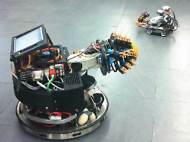Shrewbot inspired by shrew whiskers
 There are numerous examples in nature where ‘active touch’ plays a primary role in how an animal finds its way around and how it behaves. Inspired by the Etruscan shrew, one of the world’s tiniest mammals, researchers at the Bristol Robotics Laboratory (BRL) developed Shrewbot – the newest generation of a robots that use sophisticated whiskers to find its way around their environment.
There are numerous examples in nature where ‘active touch’ plays a primary role in how an animal finds its way around and how it behaves. Inspired by the Etruscan shrew, one of the world’s tiniest mammals, researchers at the Bristol Robotics Laboratory (BRL) developed Shrewbot – the newest generation of a robots that use sophisticated whiskers to find its way around their environment.
The Etruscan shrew relies on its whiskers to find, track and capture its prey during night, and the efficiency of this tiny creature has inspired scientists to look at ways of to employ a similar technique that can be used to provide the robots with ‘active touch’ rather than vision to navigate their environment. The Shrewbot has been developed at BRL in collaboration with the University of Sheffield Active Touch Laboratory as part of the BIOTACT project.
“When the whiskers touch an object this causes them to vibrate and the vibration pattern is picked up by sensitive cells in the hair follicle at the base of the whisker. These patterns are turned into an electrical signal which is sent to the brain, enabling the mammal to make instant decisions about its environment to help it move around or catch prey”, said Professor Tony Prescott from the University of Sheffield. “The whiskers have another advantage over some other forms of tactile touch. Whiskers themselves are easily replaceable since the sensory cells are at the base of the whisker, not the top, unlike our fingers for example, which are more easily damaged and hard to replace.”
The research has developed man-made whiskers that can move separately and are mounted on a mobile robot. They mimic the capability of the shrew by capturing information in the robot’s environment and allow it to make decisions about how to move in a particular environment.
“There are real advantages to this form of tactile sensing for robots that we are just beginning to understand. For example this whisker technology could have applications in dark, dangerous or smoke filled environments which are unsafe for humans, where in future we might want robots to go”, said Professor Tony Pipe from UWE Bristol. “Overall this project has taken us to a new level in our understanding of active touch sensing and in the use of whisker-like sensors in intelligent machines.”
Although you might think that touch as obsolete due to other sensors that could be used during night such as infrared cameras, LIDAR or sonar technology, the use of this technology is suitable in environments with particles that make the mentioned technologies unusable. For example, it could be used by fire departments in smoke filled rooms where vision is deeply impaired or in search situations at the bottom of murky waters.









How is this not a copy of SCRATCHbot you already wrote about?
author
Actually, it is the latest achievement by same research group.